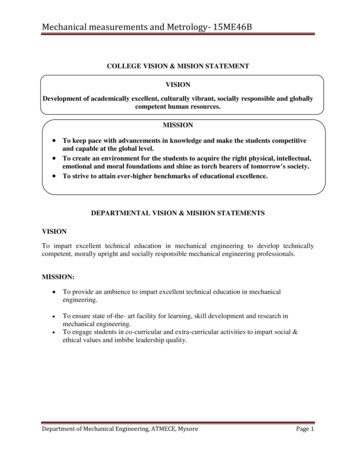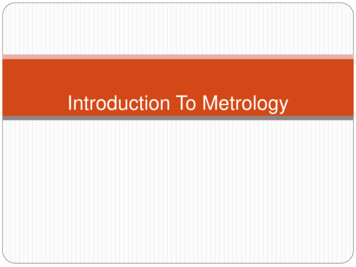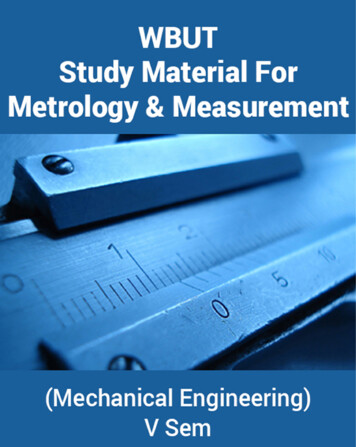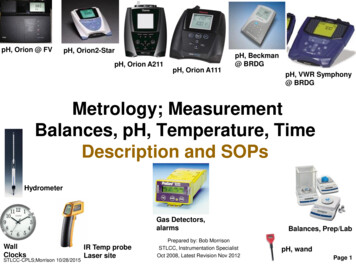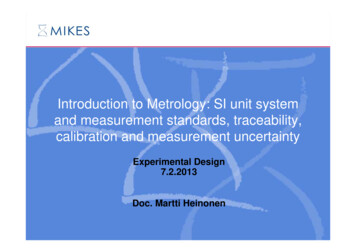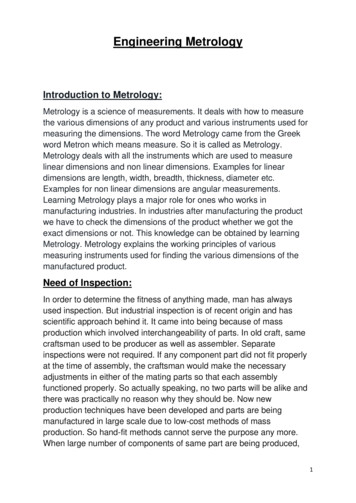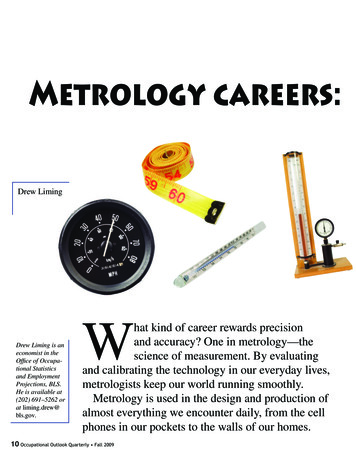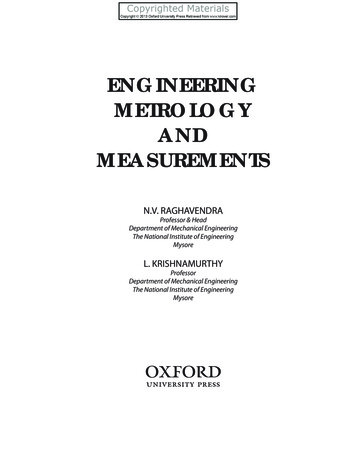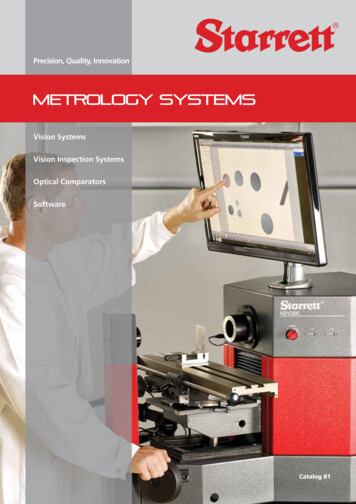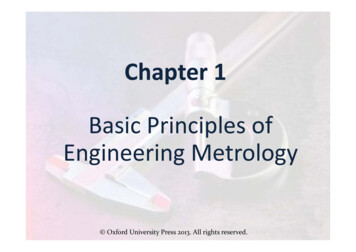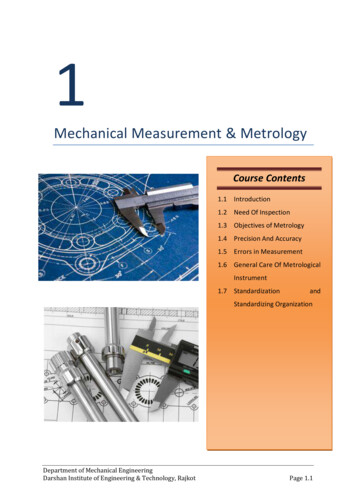
Transcription
1Mechanical Measurement & MetrologyCourse Contents1.1 Introduction1.2 Need Of Inspection1.3 Objectives of Metrology1.4 Precision And Accuracy1.5 Errors in Measurement1.6 General Care Of MetrologicalInstrument1.7 StandardizationandStandardizing OrganizationDepartment of Mechanical EngineeringDarshan Institute of Engineering & Technology, RajkotPage 1.1
Search ON Google "EME Technologies"1. IntroductionMechanical Measurement & Metrology (2141901)1.1 Introduction Metrology is a science of measurement. Metrology may be divided depending upon thequantity under consideration into: metrology of length, metrology of time etc.Depending upon the field of application it is divided into industrial metrology, medicalmetrology etc. Engineering metrology is restricted to the measurement of length, angles and otherquantities which are expressed in linear or angular terms. For every kind of quantity measured, there must be a unit to measure it. This will enablethe quantity to be measured in number of that unit. Further, in order that this unit isfollowed by all; there must be a universal standard and the various units for variousparameters of importance must be standardized. It is also necessary to see whether the result is given with sufficient correctness andaccuracy for a particular need or not. This will depend on the method of measurement,measuring devices used etc. Thus, in a broader sense metrology is not limited to length and angle measurement butalso concerned with numerous problems theoretical as well as practical related withmeasurement such as:1. Units of measurement and their standards, which is concerned with the establishment,reproduction, conservation and transfer of units of measurement and their standards.2. Methods of measurement based on agreed units and standards.3. Errors of measurement.4. Measuring instruments and devices.5. Accuracy of measuring instruments and their care.6. Industrial inspection and its various techniques.7. Design, manufacturing and testing of gauges of all kinds.1.2 Need of Inspection Inspection means checking of all materials, products or component parts at variousstages during manufacturing. It is the act of comparing materials, products orcomponents with some established standard.Page 1.2Department of Mechanical EngineeringDarshan Institute of Engineering & Technology, RajkotSearch ON Youtube "EME Technologies"
Search ON Google "EME Technologies"Mechanical Measurement & Metrology (2141901)1. Introduction In old days the production was on a small scale, different component parts were madeand assembled by the same craftsman. If the parts did not fit properly at the time ofassembly, he used to make the necessary adjustments in either of the mating parts sothat each assembly functioned properly. Therefore, it was not necessary to make similar parts exactly alike or with same accuracyas there was no need of inspection. Due to technological development new production techniques have been developed.The products are being manufactured on a large scale due to low cost methods of massproduction. So, hand fit method cannot serve the purpose any more. The modernindustrial mass production system is based on interchangeable manufacture, when thearticles are to be produced on a large scale. In mass production the production of complete article is broken up into variouscomponent parts. Thus the production of each component part becomes anindependent process. The different component parts are made in large quantities indifferent shops. Some parts are purchased from other factories also and then assembledtogether at one place. Therefore, it becomes essential that any part chosen at randomshould fit properly with any other mating parts that too selected at random. This ispossible only when the dimensions of the component parts are made with closedimensional tolerances. This is only possible when the parts are inspected at variousstages during manufacturing. When large number of identical parts are manufactured on the basis ofinterchangeability if their dimensions are actually measured every time lot of time willbe required. Hence, to save the time gauges are used, which can tell whether the partmanufactured is within the prescribed limits or not.Thus, the need of inspection can be summarized as:1. To ensure that the part, material or a component conforms to the established standard.2. To meet the interchangeability of manufacture.3. To maintain customer relation by ensuring that no faulty product reaches thecustomers.Department of Mechanical EngineeringDarshan Institute of Engineering & Technology, RajkotSearch ON Youtube "EME Technologies"Page 1.3
Search ON Google "EME Technologies"1. IntroductionMechanical Measurement & Metrology (2141901)4. Provide the means of finding out shortcomings in manufacture. The results of inspectionare not only recorded but forwarded to the manufacturing department for takingnecessary steps, so as to produce acceptable parts and reduce scrap.5. It also helps to purchase good quality of raw materials, tools, equipment which governsthe quality of the finished products.6. It also helps to co-ordinate the functions of quality control, production, purchasing andother departments of the organization.To take decision on the defective parts i.e., to judge the possibility of making some ofthese parts acceptable after minor repairs.1.3 Objectives of MetrologyWhile the basic objective of a measurement is to provide the required accuracy atminimum cost, metrology would have further objective in a modern engineering plantwith different shops like Tool Room, Machine Shop, Press Shop, Plastic Shop, PressureDie Casting Shop, Electroplating and Painting Shop, and Assembly Shop; as alsoResearch, Development and Engineering Department. In such an engineeringorganization, the further objectives would be as follows:1. Thorough evaluation of newly developed products, to ensure that components designedis within the process and measuring instrument capabilities available in the plant.2. To determine the process capabilities and ensure that these are better than the relevantcomponent tolerance.3. To determine the measuring instrument capabilities and ensure that these are adequatefor their respective measurements.4. To minimize the cost of inspection by effective and efficient use of available facilities andto reduce the cost of rejects and rework through application of Statistical Quality ControlTechniques5. Standardization of measuring methods. This is achieved by laying down inspectionmethods for any product right at the time when production technology is prepared.6. Maintenance of the accuracies of measurement. This is achieved by periodicalcalibration of the metrological instruments used in the plant.7. Arbitration and solution of problems arising on the shop floor regarding methods ofmeasurement.Page 1.4Department of Mechanical EngineeringDarshan Institute of Engineering & Technology, RajkotSearch ON Youtube "EME Technologies"
Search ON Google "EME Technologies"Mechanical Measurement & Metrology (2141901)1. Introduction8. Preparation of designs for all gauges and special inspection fixtures.Development of Material Standard The need for establishing standard of length was raised primarily for determiningagricultural land areas and for the erection of buildings and monuments. The earlieststandard of length was established in terms of parts of human body. The Egyptian unitwas called a cubit. It was equal to the length of the forearm (from the elbow to the tip ofthe middle figure). Rapid advancement made in engineering during nineteenth century was due toimproved materials available and more accurate measuring techniques developed. Itwas not until 1855 that first accurate standard was made in England. It was known asimperial standard yard. This was followed by International Prototype meter made inFrance in the year 1872. These two standards of lengths were made of material (metalalloys) and hence they are called as material standards in contrast to wavelengthstandard adopted as length standard later on.Imperial Standard Yard The imperial standard yard is made of 1 inch square cross-section bronze bar (82%copper, 13% tin, 5% zinc) 38 inches long. The bar has two 1/2 inch diameter X 1/2 inchdeep holes. Each hole is fitted with 1/10th inch diameter gold plug. The top surface ofthese plugs lie on the neutral axis of the bronze bar.The purpose of keeping the gold plug lines at neutral axis has the following advantages.-Due to bending of beam the neutral axis remains unaffected-The plug remains protected from accidental damage.The top surface of the gold plugs is highly polished and contains three lines engravedtransversely and two lines longitudinally.The yard is defined as the distance between two central transverse lines on the plugswhen,1. The temperature of the bar is constant at 62 F and,2. The bar is supported on rollers in a specified manner to prevent flexure.Department of Mechanical EngineeringDarshan Institute of Engineering & Technology, RajkotSearch ON Youtube "EME Technologies"Page 1.5
Search ON Google "EME Technologies"1. IntroductionMechanical Measurement & Metrology (2141901)Figure 1.1 Imperial Standard YardsInternational Standard Meter (Prototype) This standard was established originally by International Bureau of Weights andMeasures in the year 1875. The prototype meter is made of platinum-iridium alloy (90%platinum and 10% iridium) having a cross-section as shown in Fig. 1.2. The upper surface of the web is highly polished and has two fine lines engraved over it.It is in-oxidisable and can have a good finish required for ruling good quality of lines. Thebar is kept at 0 C and under normal atmospheric pressure. It is supported by two rollersof at least one cm diameter symmetrically situated in the same horizontal plane. Thedistance between the rollers is kept 589 mm so as to give minimum deflection. The websection chosen gives maximum rigidity and economy of costly material. The distancebetween the centers portions of two lines engraved on the polished surface of this barof platinum-iridium alloy is taken as one meter. According to this standard, the length of the meter is defined as the straight linedistance, at 0 C between the centre portions of pure platinum-iridium alloy (90%platinum, 10% iridium) of 102 cm total length and having a web cross-section as shownin Fig. 1.2.Page 1.6Department of Mechanical EngineeringDarshan Institute of Engineering & Technology, RajkotSearch ON Youtube "EME Technologies"
Search ON Google "EME Technologies"Mechanical Measurement & Metrology (2141901)1. IntroductionFigure 1.2 International Prototype Meter Cross-sections The metric standard when in use is supported at two points which are 58.9 cm apart ascalculated from Airy's formula, according to which the best distance between thesupporting points is given by Where, L total length of bar (assumed uniform), b distance between points, n number is supports For prototype meter, This reference was designated as International Prototype Meter M in 1899. It ispreserved by (BIPM) at Sevres in France. The BIPM is controlled by the InternationalCommittee of Weights and Measure. The imperial standard yard was found to be decreasing in length at the rate of onemillionth of an inch for the past 50 years when compared with internal standard meter.The prototype meter is quite stable. There-fore, yard relationship had to be defined interms of meter as 1 yard 0.9144 meter, or inch 25.4 mm.Disadvantages of Material Standard1. The material standards are influenced by effects of variation of environmentalconditions like temperature, pressure, humidity and ageing etc., and it thus changes inlength.2. These standards are required to be preserved or stored under security to prevent theirdamage or destruction.3. The replica of these standards was not available for use somewhere else.Department of Mechanical EngineeringDarshan Institute of Engineering & Technology, RajkotSearch ON Youtube "EME Technologies"Page 1.7
Search ON Google "EME Technologies"1. IntroductionMechanical Measurement & Metrology (2141901)4. These are not easily reproducible.5. Conversion factor was to be used for changing over to metric working.6. Considerable difficulty is experienced while comparing and verifying the sizes of gauges.Wavelength Standard The major drawback with the metallic standards meter and yard is that their lengthchanges slightly with time. Secondly, considerable difficulty is experienced whilecomparing and verifying the sizes of gauges by using material standards. This may leadto errors of unacceptable order of magnitude. It therefore became necessary to have astandard of length which will be accurate and invariable. Jacques Babinet a Frenchphilosopher suggested that wavelength of monochromatic light can be used as naturaland invariable unit of length. In 1907 the International Angstrom (A) unit was defined in terms of wavelength of redcadmium in dry air at 15 C (6438.4696 A 1 wavelength of red cadmium). SeventhGeneral Conference of Weights and Measures approved in 1927, the definition ofstandard of length relative to the meter in terms of wavelength of the red cadmium asan alternative to International Prototype meter. Orange radiation of isotope krypton-86 was chosen for new definition of length in 1960,by the Eleventh General Conference of Weights and Measures. The committee decidedto recommend that Krypton-86 was the most suitable element and that it should beused in a hot-cathode discharge lamp maintained at a temperature of 63 Kelvin.According to this standard meter was defined as equal to 1650763.73 wavelengths ofthe red orange radiation of Krypton isotope 86 gases. The standard as now defined can be reproduced to an accuracy of about 1 part in 10 9.The meter and yard were redefined in terms of wave length of orange Kr-86 radiation as,1 meter 1650763.73 wavelengths, and1 yard 0.9144 meter 0.9144 x 1650763.73 wavelengths 1509458.3 wavelengths.Page 1.8Department of Mechanical EngineeringDarshan Institute of Engineering & Technology, RajkotSearch ON Youtube "EME Technologies"
Search ON Google "EME Technologies"Mechanical Measurement & Metrology (2141901)1. IntroductionMeter as of Today Although Krypton-86 standard served well, technologically increasing demands moreaccurate standards. It was through that a definition based on the speed of light would betechnically feasible and practically advantageous. Seventeenth General Conference ofWeights and Measure. Agreed to a fundamental change in the definition of the meter on20th October 1983. Accordingly, meter is defined as the length of the path travelled by light in vacuum in1/299792458 seconds. This can be realized in practice through the use of an iodinestabilized helium-neon laser. The reproducibility is 3 parts in 1011, which may be compared to measuring the earth'smean circumference to an accuracy of about 1 mm. With this new definition of meter,one standard yard will be the length of the path travelled by light travelled in 0.9144 x1/299792458 sec. I. e., in 3 x 10-9 sec.The advantages of wavelength standard are:1. It is not a material standard and hence it is not influenced by effects of variation ofenvironmental conditions like temperature, pressure, humidity and ageing.2. It need not be preserved or stored under security and thus there is no fear of beingdestroyed as in case of meter and yard.3. It is not subjected to destruction by wear and tear.4. It gives a unit of length which can be produced consistently at all the times in all thecircumstances, at all the places. In other words it is easily reproducible and thus identicalstandards are available with all.5. This standard is easily available to all standardizing laboratories and industries.6. There is no problem of transferring this standard to other standards meter and yard.7. It can be used for making comparative measurements of very high accuracy. The error ofreproduction is only of the order of 3 parts in 10 11Subdivision of standardsThe international standard yard and the international prototype meter cannot be usedfor general purposes. For practical measurement there is a hierarchy of workingstandards. Thus depending upon their importance of accuracy required, for the work thestandards are subdivided into four grades;1. Primary standards2. Secondary standardsDepartment of Mechanical EngineeringDarshan Institute of Engineering & Technology, RajkotSearch ON Youtube "EME Technologies"Page 1.9
Search ON Google "EME Technologies"1. IntroductionMechanical Measurement & Metrology (2141901)3. Territory standards4. Working standards.1. Primary StandardsFor precise definition of the unit, there shall be one, and only one material standard, whichis to be preserved under most careful conditions. It is called as primary standard.International yard and International meter are the examples of primary standards. Primarystandard is used only at rare intervals (say after 10 to 20 years) solely for comparison withsecondary standards. It has no direct application to a measuring problem encountered inengineering.2. Secondary StandardsSecondary standards are made as nearly as possible exactly similar to primary standards asregards design, material and length. They are compared with primary standards after longintervals and the records of deviation are noted. These standards are kept at number ofplaces for safe custody. They are used for occasional comparison with tertiary standardswhenever required.3. Tertiary StandardsThe primary and secondary standards are applicable only as ultimate control. Tertiarystandards are the first standard to be used for reference purposes in laboratories andworkshops. They are made as true copy of the secondary standards. They are used forcomparison at intervals with working standards.4. Working StandardsWorking standards are used more frequently in laboratories and workshops. They areusually made of low grade of material as compared to primary, secondary and tertiarystandards, for the sake of economy. They are derived from fundamental standards. Bothline and end working standards are used. Line standards are made from H-cross-sectionalform.Figure 1.3 Working Line StandardsMost of the precision measurement involves the distance between two surfaces and notwith the length between two lines. End standards are suitable for this purpose. For shorterPage 1.10Department of Mechanical EngineeringDarshan Institute of Engineering & Technology, RajkotSearch ON Youtube "EME Technologies"
Search ON Google "EME Technologies"Mechanical Measurement & Metrology (2141901)1. Introductionlengths up to 125 mm slip gauges are used and for longer lengths end bars of circular crosssection are used. The distance between the end faces of slip gauges or end bars is controlledto ensure a high degree of accuracy.Sometimes the standards are also classified as:1. Reference standards- Used for reference purposes.2. Calibration standards - Used for calibration of inspection and working standards.3. Inspection standards - Used by inspectors.4. Working standards - Used by operators, during working.Line and End MeasurementsA length may be measured as the distance between two lines or as the distance betweentwo parallel faces. So, the instruments for direct measurement of linear dimensions fall intotwo categories.1. Line standards.2. End standards.Line StandardsWhen the length is measured as the distance between centers of two engraved lines, it iscalled line standard. Both material standards yard and meter are line standards. The mostcommon example of line measurements is the rule with divisions shown as lines marked onit.Characteristics of Line Standards1. Scales can be accurately engraved but the engraved lines themselves possess thickness andit is not possible to take measurements with high accuracy.2. A scale is a quick and easy to use over a wide range.3. The scale markings are not subjected to wear. However, the leading ends are subjected towear and this may lead to undersize measurements.4. A scale does not possess a "built in" datum. Therefore it is not possible to align the scalewith the axis of measurement.5. Scales are subjected to parallax error.6. Also, the assistance of magnifying glass or microscope is required if sufficient accuracy is tobe achieved.End standardsWhen length is expressed as the distance between two flat parallel faces, it is known as endstandard. Examples: Measurement by slip gauges, end bars, ends of micrometer anvils,Department of Mechanical EngineeringDarshan Institute of Engineering & Technology, RajkotSearch ON Youtube "EME Technologies"Page 1.11
Search ON Google "EME Technologies"1. IntroductionMechanical Measurement & Metrology (2141901)vernier calipers etc. The end faces are hardened, lapped flat and parallel to a very highdegree of accuracy.Characteristics of End Standards1. These standards are highly accurate and used for measurement of close tolerances inprecision engineering as well as in standard laboratories, tool rooms, inspectiondepartments etc.2. They require more time for measurements and measure only one dimension at a time.3. They are subjected to wear on their measuring faces.4. Group of slips can be "wrung" together to build up a given size; faulty wringing and carelessuse may lead to inaccurate results.5. End standards have built in datum since their measuring faces are f l at and parallel and canbe positively locked on datum surface.6. They are not subjected to parallax effect as their use depends on feel.Comparison between Line Standards and End Standards:Sr.No.1.CharacteristicLine StandardPrincipleLengthisEnd Standardexpressedasthedistance between two linesLength is expressed asthe distance betweentwo flat parallel faces2.3.4.AccuracyEase and timeLimited to 0.2mm for highHighlyaccurateforaccuracy, scales have to be usedmeasurement of closein conjunction with magnifyingtolerances up to 0.001glass or microscopemm.Measurement is quick and easyUse of end standard&requires skill and is timemeasurementconsuming.Effect of wearScale markings are not subject toThese are subjected towear. However, significant wearwear on their measuringmay occur on leading ends. Thussurfaces.it may be difficult to assume zeroof scale as datum.5.Page 1.12AlignmentCannot be easily aligned with theCan be easily alignedDepartment of Mechanical EngineeringDarshan Institute of Engineering & Technology, RajkotSearch ON Youtube "EME Technologies"
Search ON Google "EME Technologies"Mechanical Measurement & Metrology (2141901)axis of measurement.1. tureSimple to manufacture at lowManufacturing process isand costcost.complex and cost is high.Parallax effectThey ate subjected to parallaxThey ate not subjectederrorto parallax errorScale (yard, meter etc.)Slip gauges, end bars, V-Examplescaliper, micrometers etc.The accuracy of both these standards is affected by temperature change and both areoriginally calibrated at 20 0.5 C. It is also necessary to take utmost case in theirmanufacture to ensure that the change of shape with time, secular change is reduced tonegligible.Classification of Standards and Traceability In order to maintain accuracy and interchangeability in the items manufactured by variousindustries in the country, it is essential that the standards of units and measurementsfollowed by them must be traceable to a single source, i.e., the National Standards of thecountry. Further, the National Standards must also be linked with International Standard tomaintain accuracy and interchangeability in the items manufactured by the variouscountries. The national laboratories of well-developed countries maintain close tolerance withInternational Bureau of Weights and Measures, there is assurance that the itemsmanufactured to identical dimensions in different countries will be compatible.Application of precise measurement has increased to such an extent that it is notpracticable for a single national laboratory to perform directly all the calibrations andstandardizations required by a large country. It has therefore become necessary that theprocess of traceability technique needs to be followed in stages, that is, Nationallaboratories, standardizing laboratories, etc. need to be established for country, states, andindustries but all must be traceable to a single source as shown in Fig. 1.4 below.Department of Mechanical EngineeringDarshan Institute of Engineering & Technology, RajkotSearch ON Youtube "EME Technologies"Page 1.13
Search ON Google "EME Technologies"1. IntroductionMechanical Measurement & Metrology (2141901)Figure 1.4 Classifications of Standards in OrderClearly, there is degradation of accuracy in passing from the defining standards to thestandard in use. The accuracy of a particular standard depends on a combination of thenumber of times it has been compared with a standard of higher order, the recentness ofsuch comparisons, the care with which it was done, and the stability of the particularstandard itselfMeasuring system elementA measuring system is made of five basic elements. These are:1. Standard2. Work piece3. Instrument4. Person5. Environment.The most basic element of measurement is a standard without which no measurement ispossible. Once the standard is chosen a measuring instrument incorporations this standardis should be obtained. This instrument is then used to measure the job parameters, in termsof units of standard contained in it. The measurement should be performed under standardenvironment. And, lastly, there must be some person or mechanism (if automatic) to carryout the measurement.Methods of MeasurementPage 1.14Department of Mechanical EngineeringDarshan Institute of Engineering & Technology, RajkotSearch ON Youtube "EME Technologies"
Search ON Google "EME Technologies"Mechanical Measurement & Metrology (2141901)1. IntroductionThese are the methods of comparison used in measurement process. In precisionmeasurement various methods of measurement are adopted depending upon the accuracyrequired and the amount of permissible error.The methods of measurement can be classified as:1. Direct method6. Coincidence method2. Indirect method7. Deflection method3. Absolute/Fundamental method8. Complementary method4. Comparative method9. Contact method5. Transposition method10. Contactless method etc.1. Direct method of measurement.This is a simple method of measurement, in which the value of the quantity to be measuredis obtained directly without any calculations. For example, measurements by using scales,vernier calipers, micrometers, bevel protector etc. This method is most widely used inproduction. This method is not very accurate because it depends on human insensitivenessin making judgment.2. Indirect method of measurement.In indirect method the value of quantity to be measured is obtained by measuring otherquantities which are functionally related to the required value. E.g. angle measurement bysine bar, measurement of screw pitch diameter by three wire method etc.3. Absolute or Fundamental method.It is based on the measurement of the base quantities used to define the quantity. Forexample, measuring a quantity directly in accordance with the definition of that quantity, ormeasuring a quantity indirectly by direct measurement of the quantities linked with thedefinition of the quantity to be measured.4. Comparative method.In this method the value of the quantity to be measured is compared with known value ofthe same quantity or other quantity practically related to it. So, in this method only thedeviations from a master gauge are determined, e.g., dial indicators, or other comparators.5. Transposition method.It is a method of measurement by direct comparison in which the value of the quantitymeasured is first balanced by an initial known value A of the same quantity, and then thevalue of the quantity measured is put in place of this known value and is balanced again byanother known value B. If the position of the element indicating equilibrium is the same inDepartment of Mechanical EngineeringDarshan Institute of Engineering & Technology, RajkotSearch ON Youtube "EME Technologies"Page 1.15
Search ON Google "EME Technologies"1. IntroductionMechanical Measurement & Metrology (2141901)both cases, the value of the quantity to be measured is . For example, determination ofa mass by means of a balance and known weights, using the Gauss double weighingmethod.6. Coincidence method.It is a differential method of measurement, in which a very small difference between thevalue of the quantity to be measured and the reference is determined by the observation ofthe coincidence of certain lines or signals. For example, measurement by vernier calipermicrometer.7. Deflection method.In this method the value of the quantity to be measured is directly indicated by a deflectionof a pointer on a calibrated scale.8. Complementary method.In this method the value of the quantity to be measured is combined with a known value ofthe same quantity. The combination is so adjusted that the sum of these two values is equalto predetermined comparison value. For example, determination of the volume of a solid byliquid displacement.9. Method of measurement by substitution.It is a method of direct comparison in which the value of a quantity to be measured isreplaced by a known value of the same quantity, so selected that the effects produced inthe indicating device by these two values are the same.10. Method of null measurement.It is a method of differential measurement. In this method the difference between the valueof the quantity to be measured and the known value of the same quantity with which it iscompared is brought to zero.11. Contact method.In this method the sensor or measuring tip of the instrument actually touches the surface tobe measured. e.g.,
Metrology is a science of measurement. Metrology may be divided depending upon the quantity under consideration into: metrology of length, metrology of time etc. Depending upon the field of application it is divided into industrial me
